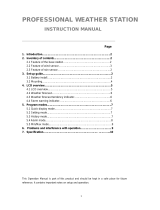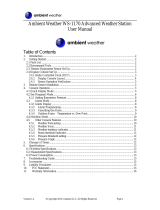
1. The ‘TEMP/HYGRO OUT’ section will display the outdoor temperature and outdoor humidity of any one of up three
thermo-hygro sensors. Use the channel key to toggle between sensors 1, 2 and 3 (sensors are optional from your
dealer).
. MIN/MAX function, with each press of the min/max key the LCD will toggle through:
• Maximum outdoor temperature
• Minimum outdoor temperature
• Maximum outdoor humidity
• Minimum outdoor humidity
h nd minimum record is displayed, the times and dates at which the records were
CD will automatically return to the normal operation mode after 15 seconds.
3. on will appear each time the sensor is transmitting out new data to the weather
4. resent the respective sensor being displayed on the LCD at that moment in time. Only
displayed at any one moment in time. Use the channel key to toggle between each of the
sensors.
5. or
re falls
elow 995hPa within a 6-hour period, the windsock is displayed slightly raised from the mast. The second step
signal appears when the air pressure falls by more than 5hPa within a 4-hour period or if the air pressure falls
r
r pressure rises to more than 990hPa.
6. y
ove
aph
unit sufficient time for air pressure reading at a consistent altitude to
provide more accurate readings. The higher the air pressure, the more circles will appear and the better the weather is
7. tory
also
t
8. ndicator is located on the right side of the air pressure bar graph. The indicator is split into four
an
9. orizontal
ast
2
• Maximum indoor temperature
• Minimum indoor temperature
• Maximum indoor humidity
• Minimum indoor humidity
W en each respective maximum a
received will be flashing. The L
The high frequency transmission ic
station
Channel’s 1, 2 and 3 icons rep
data from one channel can be
The storm-warning indicator (windsock icon) works in two steps and appears when there is an expected storm or po
weather. The first step is for moderate wind where air pressure falling by more than 4hPa or if the air pressu
b
indicates strong winds and possible stormy weather where the windsock is raised horizontally from the mast. The
stronger
to below 990hPa. The moderate storm-warning indicator will stop when the air pressure has risen by 1 hPa or if the ai
pressure rises to more than 995hPa. The stronger storm-warning indicator will stop when the air pressure rises by 1hPa
or if the ai
The electronic barometer has three weather icons, raining, cloudy and sunny for weather forecasting. This new displa
reading allows to use the instrument as an analog barometer and to check easily periods of high air pressure (ab
1013 Hpa) or periods of low air pressure (below 1013 Hpa). The smaller circles surrounding the air pressure bar gr
functions as a bar and represents the air pressure in a clockwise direction for increasing air pressure and anti-clockwise
for decreasing air pressure. Each circle (segment) is equal to 1.5hPa with the default air pressure setting at 1013hPa,
the circle bar is set to the middle of the circle for cloudy icon. Until the unit has run for at least 24 hours, weather
forecasts given should be discarded to allow the
expected to be. The lower the air pressure, the fewer the circles will appear meaning the weather is expected to
become worse. The weather icons are used as points of reference for the barometer bar of circles that run around the
main air pressure bar graph. For best results and accurate readings, the unit should operate constantly at the point of
fixing. Common to weather forecasting, absolute accuracy cannot be guaranteed but it will give users an indication of
the expected weather.
The unique weather history feature allows the user to select a time interval to record up to 170 sets of weather his
data. A set of data consists of the outdoor temperature, outdoor humidity, indoor temperature, indoor humidity, air
pressure and the associated time and date that these readings were recorded. For the outdoor data, only history from
sensor 1 will be recorded. When the history feature is used the circle bar of the barometer for weather forecasting
changes. To recall the data, press the history key once and then using the ‘+’ or ‘–‘ keys to move forward or backwards
or alternatively press and hold the ‘+’ or ‘–‘ keys to scroll through the data in fast forward and backward mode. To selec
the desired time recording interval for weather history, go to the interval setting in the ‘User setting mode’.
The weather tendency i
parts, two indicators pointing upwards and two indicators pointing downwards. When either one of the up or down
indicators are displayed, it means that there is a moderate change in the air pressure by more than 1hPa but less th
3hPa within a 4-hour period. When either both the up or both the down indicators are displayed at any one time, it
means a significant change in the air pressure has occurred by more than 3hPa within a 4-hour period. The indicator
pointing upwards represents an increase in the air pressure and the weather is expected to improve. When the indicator
points downwards, it represents a drop in air pressure and the weather is expected to become worse.
The air pressure bar graph indicates the air pressure trend over the past 12 hours with each bar along the h
axis representing 1 hour. The middle of the vertical axis (point at where the up and down tendency indicators intersect)
represents the current air pressure and each single bar change on the vertical axis is how high or low in 2hPa the p
pressure was compared to the current pressure. If the bars are rising it means that the weather is improving due to the
7




















